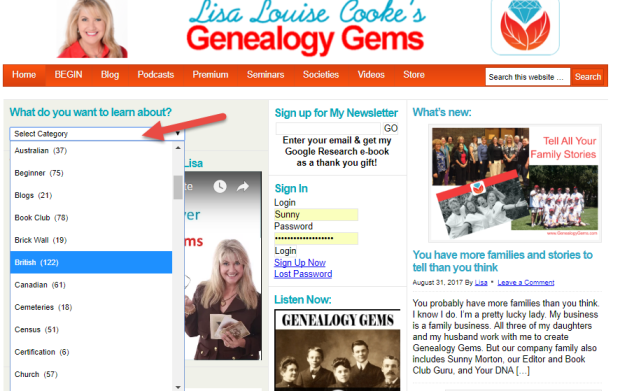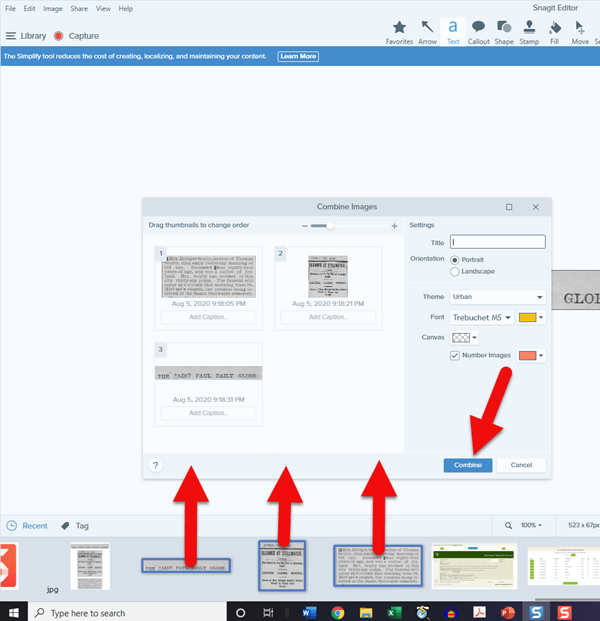by Lisa Cooke | Sep 1, 2017 | 01 What's New, British, Records & databases
English genealogy records abound in this week’s roundup of new family history records online. Find England BMD, parish records, newspapers, and more. Also: an important addition to the British Newspaper Archive’s Irish newspaper collection, over 1,000 years of Chinese documents and records, German vital records, parish records for Italy and Sweden, and new US collections for VA, OH and NY.
English Genealogy Records Now Online
Ancestry.com subscribers can now search these English genealogy record collections:
-
-
-
-
- Bedfordshire Petty Sessions 1854-1915 This collection includes details of over 100,000 individuals involved in petty session hearings in Befordshire. Details for each individual may include name, role in the case, date of the hearing, location of the court, and even the fines or punishments given to the defendant(s).
- Bedfordshire Valuation Records 1838-1929 These records deal solely with the value of properties in Bedfordshire county. The volumes name the proprietor or tenant, describe or name the property and give an annual rental value. It will also sometimes give an acreage for the property.
- Bedfordshire Land Tax Records 1797-1832 Details found within this collection include may include year of residence, name of occupier, name of owner, and parish of residence.
- Shropshire Extracted Church of England Parish Records, 1538-1812. This collection of indexes is taken from various published versions of parish and probate records from Shropshire, England dating from the early 1500s (with some non-parish records earlier) to the late 1800s. “The records include baptisms/christenings, burials, marriages, tombstone inscriptions, obituaries, tax lists, wills, and other miscellaneous types of records,” states the collection description. “Also included are some records from non-conformist churches.”
At FamilySearch.org, you can now search a free collection of Staffordshire Church Records. In partnership with Findmypast’s expansion of Staffordshire records, this collection provides church records from 1538-1944. Nearly 5 million indexed records and over 278,000 images are included.
Over at Findmypast, subscribers can now search extensive new collections for Buckinghamshire. (The original records are held at the Buckinghamshire Archives.) New databases include:
-
-
-
-
- Buckinghamshire Baptism Index 870,000 transcripts created from original records held at the Buckinghamshire Archives. You will also discover your ancestor’s birthplace, the date of the baptism, their father’s occupation and residence.
- Buckinghamshire Banns Index Explore 101,000 records created from original parish registers and bishop’s transcripts. “Each transcript will reveal the name of your ancestor’s intended spouse, the couple’s residence, the dates the announcements were read and their intended date of marriage.”
- Buckinghamshire Marriage Index Over 485,000 transcripts “will reveal the couple’s birth years, marital status, occupation, date of marriage, place of marriage, residence, occupation, father’s names, father’s occupations and the names of any witnesses.”
- Buckinghamshire Burial Index More than 662,000 transcripts are included, created from original parish registers and bishop’s transcripts. “Each record will reveal your ancestor’s birth year, age at death, burial date, and residence. An archive reference is also included, allowing you to locate a copy of the original document.”
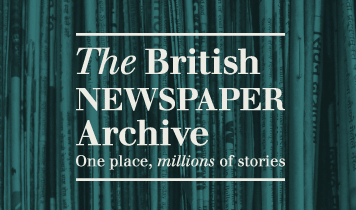 British and Irish Newspapers Now Online
British and Irish Newspapers Now Online
Over 2.3 million new articles and 7 brand new titles have been added to the British Newspaper Archive’s collection of historic newspapers this month. New titles now available to search include:
- Tenby Observer
- Brechin Herald
- Milngavie and Bearsden Herald
- Alcester Chronicle
- Abergavenny Chronicle
- Ripley and Heanor News and Ilkeston Division Free Press
- Eastern Daily Press and the Colchester Gazette
Click here to explore these and other historic British Newspapers.
More than 5,000 pages from the Leitrim Advertiser have been added to Irish newspapers at the British Newspaper Archive. From the description: “The paper was originally published in Mohill, Leitrim and known in later years and The Leitrim and Longford Advertiser.” The earliest issue dates back to 1886, through 1916. With this addition, the British Newspaper Archive now has a newspaper for every county in Ireland!
German Births and Deaths: Bischofswerda
Ancestry.com has added new collections for Bischofswerda births (1876-1902) and deaths (1876-1951). Bischofswerda is located about 22 miles east of Dresden at the edge of Upper Lusatia in the German state of Saxony. To local residents, it is also known as “Schiebock” and known for its large historic market square and town hall.
Italian civil registration: Padova
FamilySearch has published 42,000 newly indexed records and images in its free collection,
Civil Registration Records: Padova 1621 – 1914. From the collection description: “Civil registration of births, marriages, and deaths within the custody of the State Archive of Padova. Includes supplemental documents, residency records, ten-year indexes, and marriage banns. Availability of records is largely dependent on time period and locality.”
Swedish Household Examination Books
Also at FamilySearch are 1 million indexed records and images for
Swedish Household Examination Books 1880-1920. According to the collection, “Each year until 1894 the Parish Priest would visit each home in the parish and test each individual’s knowledge of the catechisms. In addition, they would collect birth, death, and marriage dates as well as where families had moved to or from and when, etc. The priest would then come back each year and update or edit the information from the previous year and note any changes in the population of the home.” (These are also online at
MyHeritage.com.)
Click here to read a great article for getting started on your Swedish genealogy.
Chinese Records at the Library of Congress
An exciting announcement from the Library of Congress this week! “The contents of the Asian Division’s Pre-1958 Chinese Collection, totaling more than 42,000 items, are now fully searchable through the Library’s online catalog in both Chinese characters and Romanized script. This rich and diverse collection has served researchers and general audiences for nearly 90 years; until now, however, bibliographic records for these materials were only available through a card catalog.”
United States
New York. The Vassar College Digital Newspaper Archive is now available online. Provided by the Vassar College Libraries, this archive provides access to newspapers published by Vassar College students. Earliest issues date back to 1872, and cover a wide range of topics and events on and off campus. This collection currently contains over 85,000 pages.
Ohio. New at Ancestry this week are Ohio Soldier Grave Registrations, 1804-1958. This database contains grave registration cards for soldiers from Ohio who served in the armed forces, mainly from the time of the War of 1812 up through the 1950s. Records may contain an individual’s name, date and place of birth, date and cause of death, location of burial, next of kin, military service information, and more.
Also in Ohio, Kent State University has completed the digital Daily Kent Stater Archive. It contains 90 years of Kent State student publications, dated from Feb 1926 to Dec 2016. According to the
press release, “it covers several historic events as well as some great memories for the Kent State alumnae.” Check out the introductory video!
Did you know? You can search the Genealogy Gems website for articles about your favorite genealogy categories–including records and research tips for several countries and ethnicities. Go to our home page and click on the dropdown menu under What do you want to learn about? Scroll down to see the various categories or start typing a few letters to jump down to that part of the alphabetical list.
Disclosure: This post contains affiliate links and Genealogy Gems will be compensated if you make a purchase after clicking on these links. Thank you for supporting Genealogy Gems!
by Lisa Cooke | Aug 8, 2020 | 01 What's New, Elevenses with Lisa, Premium Video, Research Skills |
Episode 19 Video and Show Notes
Join me for Elevenses with Lisa, the online video series where we take a break, visit and learn about genealogy and family history. (scroll down to watch the video)
Genealogy Consultation Provides a Strong Hypothesis
My 45-minute consultation with a genealogy expert Kate Eakman at Legacy Tree Genealogists broke things wide open on my Irish family lines and gave me the information and resources I needed to make all of the progress I shared in this episode. It’s the best investment I’ve made in my genealogy in a long time. They have experts in all areas. Learn more about how easy it is to book a consultation here.
After my consultation I needed to update my research plan and get to work collecting more genealogical evidence.
Let’s quickly recap what happened when I started working on my brick wall last week in episode 18:
- Margaret Lynch’s death certificate said her parents were James Scully and Bridget Madigan.
- Her obituary said she was born in Limerick Ireland.
- There was one couple by those names in Limerick, having children and the right time. There is a gap in the records where Margaret should be.
- Her husband Michael Lynch dies in Stillwater MN. St. Michael’s Catholic church. Found their marriage record in Stillwater. It was a large booming town, and a good place to focus. The Lynch family had a farm across the river in Farmington, Wisconsin.
My research question: Was this couple we found, James Scully and Bridget Madigan, who married in Kilcolman, Limerick, Ireland in 1830, the parents of Margaret Scully?
What Kate Eakman of Legacy Tree Genealogists helped me do in my 45-minute consultation:
- Become acquainted with a variety of excellent Irish research websites
- Located the indexed marriage record for James and Bridget
- Located the original marriage record for James and Bridget
- Located the indexed baptismal records for all of the children who had James and Bridget listed as their parents.
A Genealogy Research Plan for Collecting Evidence
After the consultation I developed a new research question: Are the children that we found records for in Ireland the siblings of my Margaret Lynch?
My research plan included:
- Verify if there were any other couples by the names James Scully and Bridget Madigan married in Ireland, particularly in the time from of circa 1830. (Location of source: RootsIreland.ie)
- Search in the U.S., starting in the area where Margaret lived, for each child. I’m looking for records that name these same parents, and show the child at an age that correlates with the baptismal date.
I identified several sources I believed would help me accomplish my goals.
Marriage Records – I conducted a search for James in Bridget in all counties in Ireland. I discovered that the couple Kate found during my consultation is the only couple in the RootsIreland database with those names married in Ireland. This gives me more confidence that I have the correct couple.
U.S. Records – Armed with the names and ages of the children of James and Bridget, it was time to return to America. I needed to search U.S. records to see if any of the children came to America (perhaps living near Margaret) and if these parents were named.
Records to look for:
- U.S. Federal Census (Ancestry, FamilySearch), and State Census (Minnesota Historical Society, Ancestry, FamilySearch)
- Death records (Minnesota Historical Society, FamilySearch.)
- Newspapers, particularly obituaries possibly naming parents or Limerick. (Minnesota Historical Society, Newspapers.com)
Before I began my search I created an excel spreadsheet to capture the information. I included columns for what their ages should be in each census.

Using a spreadsheet to track my findings.
Now I was ready to start the genealogical hunt!
U.S. Census
Search each sibling one at a time in the census.
- Focus on Washington Co., Minnesota (marriage and death location for Margaret & Michael Lynch)
- Move on to Polk County Wisconsin, and greater Wisconsin.
- Search both U.S. Federal Census & State Census
- Top locations identified for this search: Ancestry.com, Familysearch.org, Minnesota Historical Society
Results:
- Found individuals matching the sons in Stillwater and Baytown (Washington County)
- Found Bridget Scully (Mother) living with various sons in various census records.
- Immigration years listed for some of Margaret’s siblings.
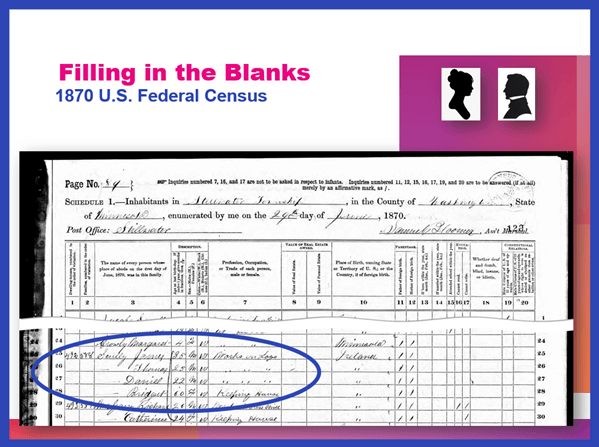
Found in the 1870 U.S. Federal Census: James, Thomas, Daniel and Bridget.
I created folders for each sibling marked MAYBE and collected the records on my hard drive.
Learn more about hard drive organization in Elevenses with Lisa episode 8.
Searched FamilySearch and the Minnesota Historical Society for a death record for each son.
- Found Thomas and James.
- James Scully and Bridget Madigan listed as parents
- Ages matched
- Next step: order the death certificates
Newspapers
Next I searched the Minnesota Historical Society website for newspapers.
Results:
- 170+ articles
- Two obituaries for Bridget Scully! (8 children, immigration year, husband died in Ireland implied)
- Found James Scully working with his brother and his obituary
Research Tip: Look at a map and identify nearby towns and larger cities. Expand your search to these areas.
I found a James Scully in the 1860 census with Bridget and his brothers, and working with Thomas in many newspaper articles.
Bridget’s obituary said she came to America with 8 children. 7 had baptismal records in Ireland. James and Margaret were not found in the baptismal records but were confirmed in U.S. records to have the same parents. That would be a total of 9 children. It’s possible one of the daughters that have not yet been found in U.S. records may have died in Ireland prior to their leaving for America.
I then combed back through my Lynch binder – I might spot something that I marked as unsure, or that might jump out at me now that didn’t 20 years ago.
- Found History of the St. Croix Valley I had photocopied a section. Names Daniel Scully (who I have since found in the census, newspapers and death records) and says his parents are James Scully and Bridget Madigan!
- Looked the book up in Google Books. It’s fully digitized. Now I can extensively read and search it.
Tech Tip: Clip and combine newspaper clippings with SnagIt software
Clipping and saving newspapers poses a unique challenge for genealogists:
- Clipping a small portion of a very large digital newspaper page can result in a low resolution file.
- If you clip an article you don’t always capture which newspaper and issue it came from
- Articles often continue in different locations on the page or pages, making it impossible to capture the entire article in one image.
I use SnagIt software to clip my newspaper finds. I can then save them to Evernote or archive them on my hard drive. SnagIt can save your clippings in wide range of file types and can even clip video. You can get your copy of SnagIt here. It’s a one time fee and download – no subscription! (Thank you for using my link – it financially supports this free without any added expense to you.)
How to combine multiple clippings with Snagit:
- Clip the paper title and date
- Clip the article
- Clip any additional applicable sections of the article
- In the SnagIt menu under Image click Combine Images
- Drag and drop the clippings into the desired order
- Click the Combine button
- Save the combined image: In the menu File > Save As (you can select from a wide variety of file types)
Research Tip: Using Street Addresses in Google Earth
When you find a street address, whether in a newspaper, city directory, census or other genealogical record, use it to find the location in the free Google Earth software program. You can then save an HD quality image of the location.
How to find a location in Google Earth (on a computer):
- Type the address into the search field in the upper left corner
- Click the Search button
- The map will automatically “fly to” the location and a pin will mark the general spot.
- Hover your mouse pointer in the upper right corner of the to reveal the navigation tools. Click the plus sign to zoom in closer.
How to view the location with Street View:
- Zoom in relatively close so that the street and buildings are distinctly visible.
- Just above the zoom tool you will find the Street View icon (the yellow “peg man”). Click on the icon and drag it over the street in front of the building / location. Don’t release your mouse. It may take a second or two for the blue line to appear indicating that Street View is available in that location. If no blue line appears street view is not available.
- When the blue line is visible, drop the Street View icon directly onto the blue line in front of the location you want to view. by releasing your mouse. If you miss the line and the picture looks distorted, click the Exit button in the upper right corner and try again.
- Once on Street View, you can use your keyboard arrow keys to navigate. You can also click on further down the street to move forward that direction.
How to save an image of a street view location:
- Position yourself in the best view of the desired location using your mouse and keyboard arrow keys as described above.
- In the toolbar at the top of the screen, click the Image icon (it looks like a portrait-oriented page, near the printer icon)
- A Title and Description box will appear at the top of the screen beneath the toolbar. Click it and type in a title and description for your image if desired.
- You can adjust the size (resolution) of the image you will be saving by clicking the Resolution button above the title box.
- When you’re ready to save the image to your hard drive, click the Save Image
Learn more about using Google Earth for genealogy in Elevenses with Lisa episode 12.

Order the video training series at the Genealogy Gems Store featuring 14 exclusive step-by-step video tutorials. The perfect companion to the book The Genealogists’s Google Toolbox by Lisa Louise Cooke.
After a week of post-consultation research:
Question: Who were the parents of Margaret Scully born in Limerick Ireland on approximately July 9, 1840?
Answer: James Scully and Bridget Madigan, married in Limerick, Ireland June 13, 1830. (Though I feel confident about this, I still have additional records I want to find in order to further solidify this conclusion.)
Question: In what Parish was Margaret Lynch born?
Answer: Most likely Kilcolman based on the baptismal locations of her siblings.
My Next Research Steps:
- Browse search through the baptismal parish records at NLI 1839-1842 for Margaret, and 1834-1836 for James Scully.
- Look for marriages of Margaret’s female siblings, and family burials.
(Contact St. Michael’s church, Stillwater, MN.)
- Go through newspapers.com – there are several Minneapolis and St. Paul papers running articles from Stillwater.
- Resume my search of passenger list records with the newly revised date of c. 1851.
- Search for the death record of Bridget’s husband James at RootsIreland and NLI.
How to Book a Genealogy Consultation
My 45-minute consultation with a genealogy expert Kate Eakman at Legacy Tree Genealogists broke things wide open on my Irish family lines and gave me the information and resources I needed to make all of the progress I shared in this episode. It’s the best investment I’ve made in my genealogy in a long time. They have experts in all areas. Learn more about how easy it is to book a consultation here.
Learn More:
For more step-by-step instructions for using Google Earth read my book The Genealogist’s Google Toolbox available at the Genealogy Gems Store.
Recommended Genealogy Gems Premium Member Videos with downloadable handouts:
Learn more about Genealogy Gems Premium membership here.
Genealogy News: Free Webinar
Watch the free video recording of my session on the MyHeritage Collection Catalog here.
Resources:
Live Chat PDF– Click here to download the live Chat from episode 19 which includes my answers to your questions.
Genealogy Gems Premium Members:
Become a Premium Member here.
by Lisa Cooke | May 23, 2019 | 01 What's New, Genealogy Gems Podcast |
with Lisa Louise Cooke
May 2019
Listen now, click player below:
Download the episode (mp3)
In this episode:
- Two listeners shares an exciting find using Lisa’s research strategies
- Lisa provides next steps on German research in response to a listener question
- Your Master Family Tree, and Sharing Branches Online Explained
- The unusual history of one of the earliest forms of the World Wide Web
NEWS:
Lisa Louise Cooke is back in the studio after two weeks on the road speaking at the Ohio Genealogical Society (OGS) Conference and the National Genealogical Society (NGS) Conference.
Each conference was great and had its own unique feel, and there were many new genealogists in attendance.
Genealogy Gems listener Carol stopped by and enthusiastically shared with how the eBay search strategies for family history that Lisa discussed in episode 140 paid off in a big way!


MAILBOX:

Robin wrote in to share how Sydney Orton’s song with her grandpa in Genealogy Gems Podcast episode 228 brought her to tears in a toll plaza while driving!
Steve wrote in to rave about the value that his new Genealogy Gems Premium eLearning membership has brought to his family history research.
Rylee says she’s grateful to have found the podcast and she shares a story of genealogical discovery that she hopes will inspire others. Rylee asks “How do I find sources for these people? I have searched all over ancestry and Family Search and have had no luck again. I really want to believe that the people I have as Adam’s parents and siblings all the way through his 2nd great-grandparents (paternal) are truly his family but I need to get more information. Where can I go for help with German records and where can I continue my search?”
Lisa’s comments: You’re absolutely right, what you found are just hints. It sounds like it’s time for you to move on from the “Genealogy Giants” (Ancestry, FamilySearch, etc.) and into German records websites, libraries, and archives to find real sources that nail down the family tree.
Lisa recommends the Genealogy Giants quick reference comparison guide.
We have several articles and episodes at Genealogy Gems that can help you do this:
- Go to genealogygems.com
- At the top of the home page select “German” from the “Start Learning” drop down menu
- That will take you to these results pages featuring our German research strategies.
I’m optimistic for you because Germans are known for keeping excellent records, and I have had good luck in searching them.
GEM: Your Master Family Tree, and Sharing Branches Online Explained

I describe it this way: Plant your tree in your own backyard and share branches online.
A master family tree has three important characteristics:
- It is owned and controlled by you.
- It is the final say on what you currently know about your family tree.
- It is protected with online backup to ensure it is safe.
Plant Your Master Family Tree
Lisa uses RootsMagic software for her master family tree. Learn more about GEDCOM files in this article: GEDCOM File (What is It & How to Use This Genealogy File)
Protech Your Master Family Tree
Lisa uses Backblaze to back up her master family tree and computer. Visit www.backblaze.com/lisa
(Using this link also helps keep this free podcast free. Thank you!)
Read more: How to Download Backblaze in 4 Easy Steps

Share Branches Online
Genealogy Giants Guide available in the Genealogy Gems store.

Read Lisa’s article: Planting Your Master Genealogy Family Tree for all of the strategies mentioned in this episode.
The free podcast is sponsored by:


PROFILE AMERICA: Friday, May 24th, 2019
In a way, today marks the 175th birthday of the World Wide Web. Only it was electro-mechanical, not digital. On this date in 1844, Samuel F.B. Morse activated the first telegraph line, sending a dots-and-dashes code message from the U.S. Capitol building to a receiver in Baltimore.
By the late 1850s, the first telegraph cable had been laid across the Atlantic Ocean, and in 1861, the telegraph spanned the continental United States. Over the ensuing decades, the wires wrapped around the world.
From the 1844 demonstration, telecommunications today has grown into a half-trillion dollar a year industry, and employs more than 1 million workers in over 59,000 industry establishments.
You can find more facts about America from the U.S. Census Bureau online at www.census.gov.
Sources:
Joseph Nathan Kane, Kane’s Famous First Facts, Fifth Edition, H.W. Wilson Co., New York, NY, 1997, #7692.
Become a Genealogy Gems Premium eLearning Member

Gain access to the complete Premium Podcast archive of over 150 episodes and more than 50 video webinars, including Lisa Louise Cooke’s newest video The Big Picture in Little Details.
Learn more here.
(Membership doesn’t auto-renew because we don’t like that either. Prior to your membership expiring you’ll receive a friendly reminder email from us.)
Genealogy Gems App Users
Don’t miss the bonus content in this episode. Tap the “gift” icon on the episode screen in the app.
Get the app here or search for “Genealogy Gems” in your device’s app store.
Download the Show Notes PDF in the Genealogy Gems Podcast app.
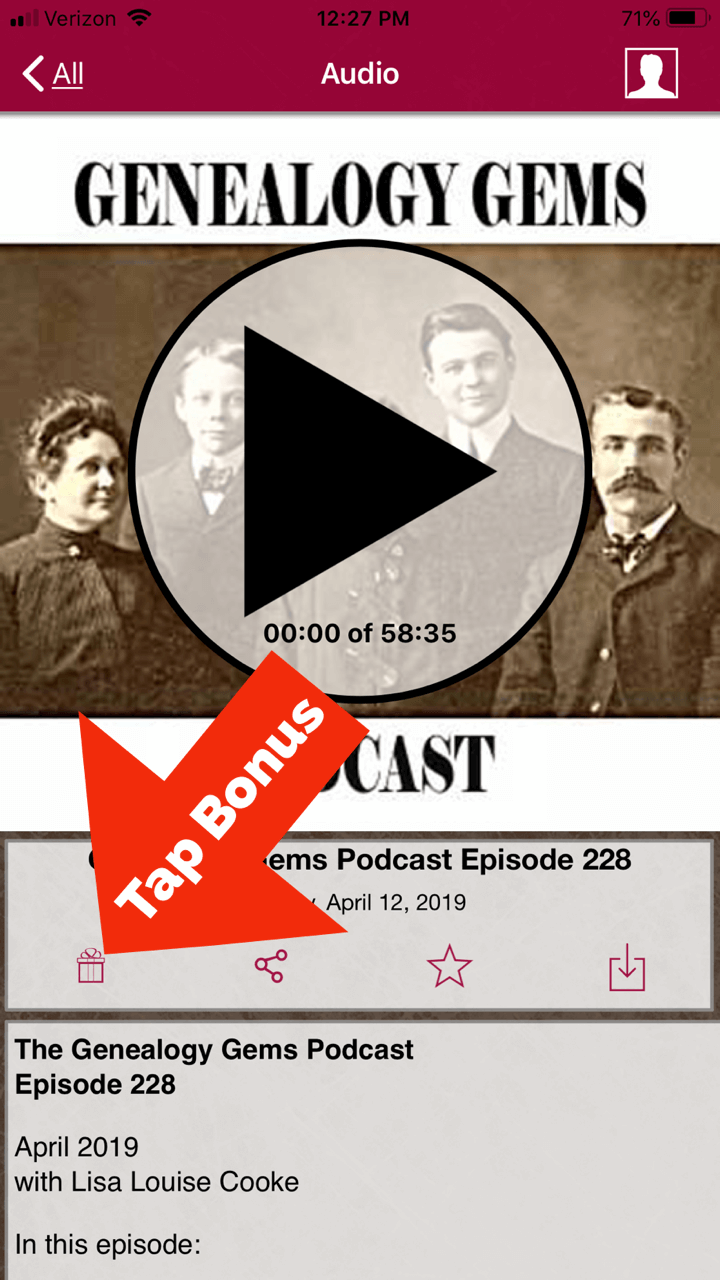
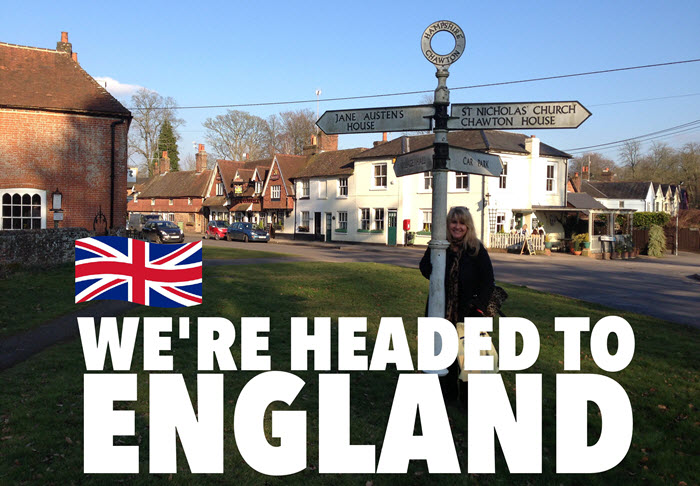
 British and Irish Newspapers Now Online
British and Irish Newspapers Now Online